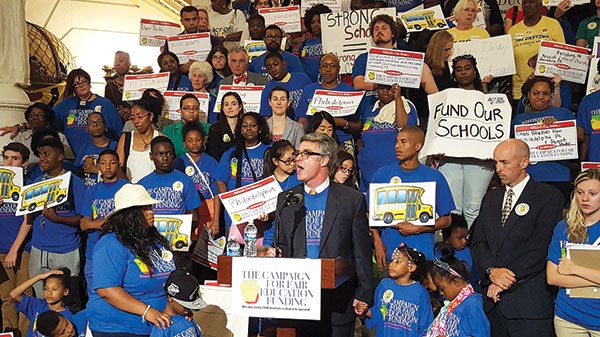Montgomery County, Montour County, Northumberland County, Allegheny County and Philadelphia. Shoulder to shoulder, hundreds from across the state stood on the white steps of the rotunda of the Pennsylvania Capitol in the Harrisburg last week.
Clad mostly in blue T-shirts, the diverse crowd formed a backdrop with signs that read: "Fund Our Schools," "All PA Kids Are Our Children," "Strong Schools = Strong Communities" and "Every Baby Needs a Laptop."
Among them were teachers and librarians, preschoolers and high schoolers, parents and recent graduates. Along with the line of speakers who graced the podium one by one, the riser of Pennsylvanians 10 rows high formed a patchwork quilt of concern.
"We are all here today because we have a problem in Pennsylvania," said Susan Gobreski, executive director of Education Voters Pa. "That problem is that every child does not have access to an education that allows them to learn what we expect someone to learn to graduate from high school. Why? Because we are not providing it. The primary cause of this is unfair and insufficient funding, resulting in disparities in opportunity from community to community."
At the June 23 rally in Harrisburg, hundreds called for a basic education funding formula that would ensure a transparent and equitable distribution of state funds to school districts.
Pennsylvania is one of only three states that does not use a funding formula to divvy up funds to school districts. As a result, the state has the widest gap in per-student funding between wealthy and poor districts. According to data from the National Center for Education Statistics, poor districts spend 33 percent less than wealthy districts across the state.
But there's reason to be hopeful. Days before the rally, the Basic Education Funding Commission released recommendations for a funding formula that would take into account the student population and needs of each district.
"Just last week, the bipartisan Basic Education Funding Commission reached unanimous agreement on recommendations for a new funding formula," says Patrick Dowd, executive director of Allies for Children, a local advocacy organization. "It is now time for all of our lawmakers to finish this work and enact a fair, sustainable and predictable public-school funding system that provides sufficient funding so every student has an opportunity to succeed."
While many champion the commission's efforts, others aren't quite ready to celebrate. A more equitable funding formula will surely aid struggling districts, but some worry whether the state will be able to come up with the additional dollars necessary to even the scales.
"New dollars are going to have to be put into the system in order for the formula to have an effect," says Dowd. "We think in order for basic education to be accurately funded, the state needs additional dollars."
Funding in Pennsylvania hasn't always been so disparate. During former Gov. Ed Rendell's administration, the state had a basic education funding formula that granted a base level of funding to each district, and additional funding based on factors like the number of students living in poverty and population changes.
This formula was eliminated under former Gov. Tom Corbett. The current system allocates funding to districts without taking into account demographic changes from year to year.
"Pennsylvania's funding system is broken. We don't have a fair method of providing 500 school districts with funding," says Dowd. "It's not accurate. Currently, the state doesn't even count kids in a school district. Everybody would agree you have to know how many kids are being served."
For districts throughout the commonwealth, this disparity has manifested in different ways.
Librarians, air conditioning, smart boards, gym class, art class or a full-time music teacher are just some of the things school districts across the state say they are missing as a result of disparate education funding.
Nearly all school districts in the state have reduced staff in recent years. Half have furloughed teachers or other staff; 74 percent have eliminated or reduced one academic program or more; and 57 percent have increased class sizes.
Additionally, less than half of the 1.8 million students across the state have access to a school librarian. And only 3 percent of school libraries are funded at the recommended level.















